Day 1 of a weekend of Summer Tours looking for birds, butterflies and other wildlife. It was bright and sunny, with patchy high cloud for most of the morning, but cloudier and cooler as the breeze picked up a little in the afternoon. We made our way down to The Broads for the day.
As we set off, we hadn’t gone far when we spotted a Little Owl in the window opening of an old barn. We pulled up a discrete distance away but before we could get out it had disappeared inside. The rest of the journey down to the Broads was fairly quiet, the only bird of real note being a Grey Wagtail which flew up from the side of the road at one point.
Early reports suggested that the Lesser Grey Shrike which has spent the last week along the Nelson Head track at Horsey was still present this morning, so we headed straight round there first. A Swallow was singing from under the eaves of the Nelson Head pub.
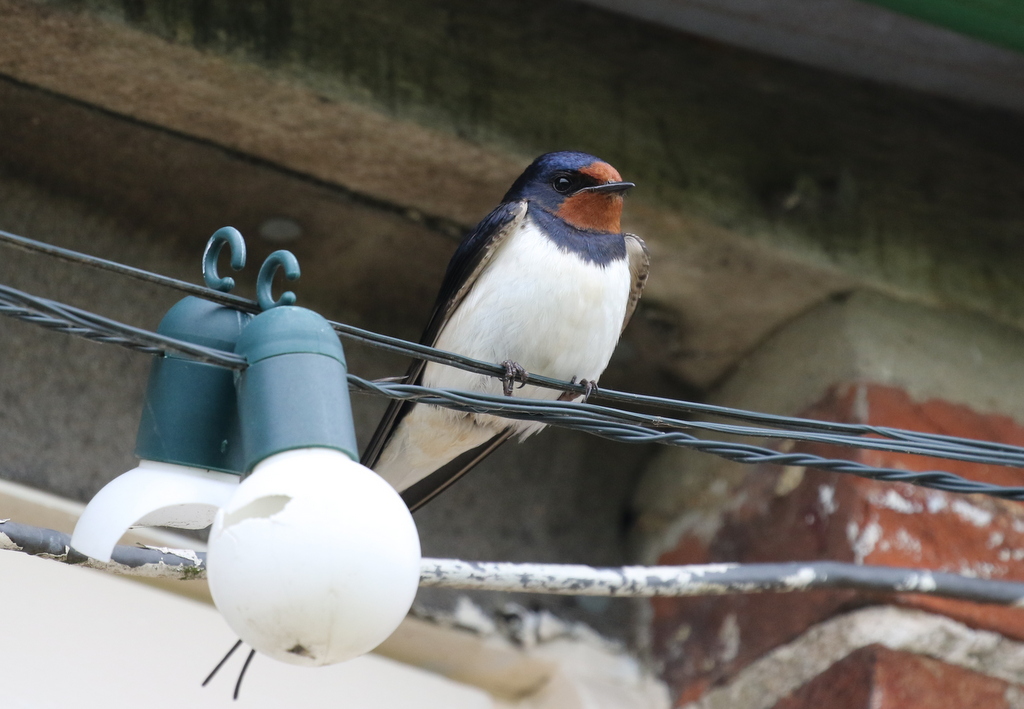
As we walked down the road, a Common Whitethroat was singing from an oak tree in the hedge on the edge of one of the fields. There were small flocks of Linnets flying in and out of another oilseed rape field, feeding on the seeds. We took the track out towards the dunes and several Skylarks towered up into the blue sky, probably making the most of it after the last week’s rain. A Reed Warbler sang from a reedy ditch by the path, but remained mostly out of view, even though we could see the reeds moving. A male Reed Bunting perched on some brambles was singing too, as best it could!
There were a few people gathered already this morning, looking at the Lesser Grey Shrike, so we joined them. The bird was out at the back of a grassy meadow with scattered bushes. It was perched on a branch low on the edge of a clump of sallows at first, so we got it in the scope. We could see its black mask extending up over its forehead and the pink flush to its breast. It was very active, flying between bushes and sallying out over the grass for insects.
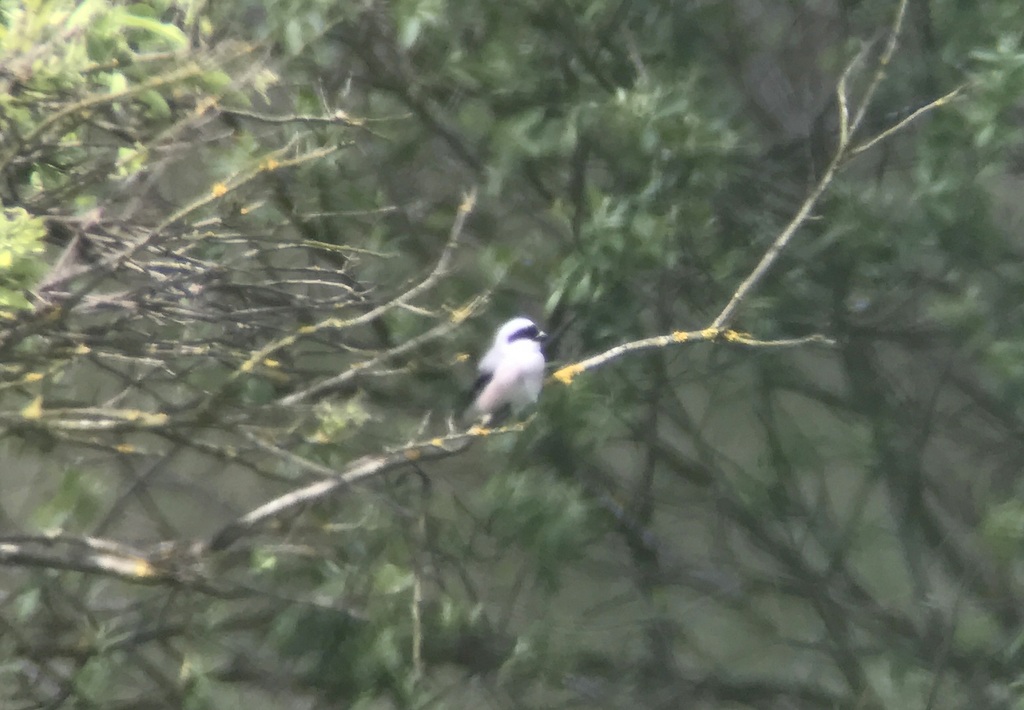
Lesser Grey Shrike is a scarce visitor to the UK from south-eastern Europe, with on average only 1-2 seen each year. We stood and watched it for a few minutes, before it flew round behind a large area of bushes and we lost sight of it. A Hobby shot through low over the grass, hunting dragonflies. We decided to walk on to the dunes.
There has been an invasion of Painted Lady butterflies from the continent in the last few days and there were lots here this morning. Everywhere we looked over the grassy meadows, we could see them flying round. Along the edge of the path, there were small groups feeding on any nectar-bearing flowers that were open. An impressive sight to see so many here.
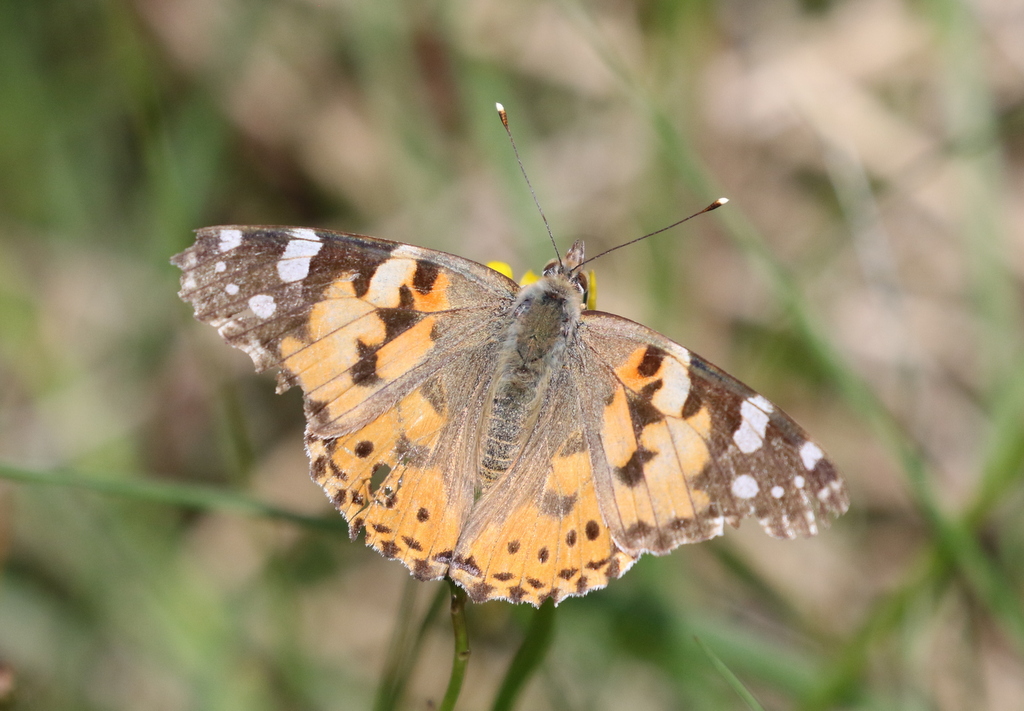
Further along the path, the verges were lined with several clumps of purple Southern Marsh Orchids coming into flower. A Curlew flew high overhead calling, heading south. Amazing to think, but the first waders are already coming back after the breeding season further north and there have been a few Curlews on the move in recent days. Their summer is over already, just as ours is hopefully beginning!
We carried on out to the dunes and climbed up to the top to look at the sea. There were a few gulls offshore and a Grey Seal diving just off the groynes. We had a quick scan from up here but there were lots of small beetles buzzing around in clouds which started to get in people’s hair, so we decided to make our way back.
We were just about to descend when we noticed a Hobby, possibly the one we had seen earlier, hawing for insects low over the top of the dunes just to our right. It came along the line of the dunes towards us, then shot fast and low down over the grassy slope right below us, catching something low over the grass and then coming back up to eat it as it passed.
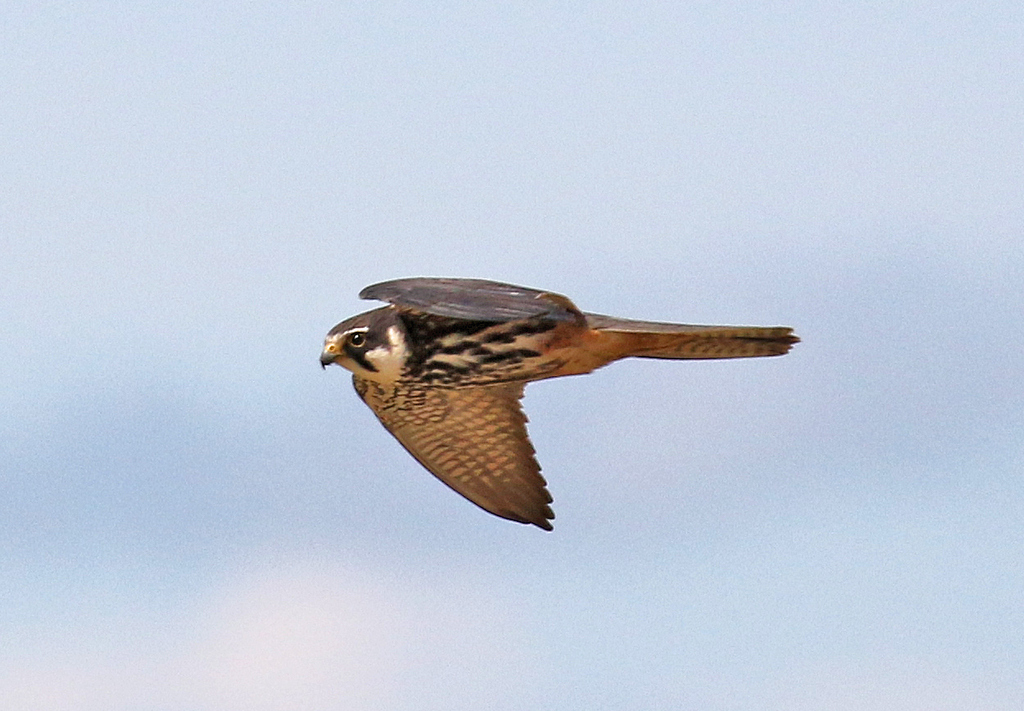
As we made our way back to the track, a pair of Stonechats were on the fence. They flicked off ahead of us, landing each time a bit further along. The male flashed a bright white rump as it flew – a characteristic more typical of continental Stonechats rather than the darker British race hibernans. The taxonomic status of the Stonechats on the coast here is uncertain and it is possible that continental rubicola Stonechats intergrade with hibernans here.

The Lesser Grey Shrike had come out again and was now feeding along a fence line across the fields, repeatedly sallying out from a dead stem and returning to the same perch. It attracted the attentions of the Stonechat and a Reed Bunting here, which perched close by, the Stonechat chasing after it at one point. The Lesser Grey Shrike seemed to take little notice.
On the way back to the minibus, we stopped to help a Garden Tiger moth caterpillar off the path and rescue a Four-spotted Chaser dragonfly from a puddle. A pair of Common Whitethroats was carrying food in and out of the hedge and a Greenfinch was wheezing from the top of an ash tree.
We headed round to Potter Heigham next. As we made our way in along the track, there were lots of dragonflies zooming around between the reeds, Norfolk Hawkers and Black-tailed Skimmers. A pair of Egyptian Geese were out on the grazing meadows. We could see a Spoonbill on the back of one of the pools, busy feeding with its head down and moving its bill quickly from side to side through the shallow water. The next pool had a large area of exposed mud in the middle. Several Lapwing were on here, including a good number of well-grown juveniles. A Little Ringed Plover was lurking in between two sleeping Shelducks.
At the end of the track, we climbed up onto the bank. Our main target for the day was Swallowtail butterfly and as we came through the trees one shot past us over the tops of the reeds. We saw several as we walked along here, but they were all flying fast and none were showing any signs of settling. The brambles and thistles are not in flower yet this year, so there are not so many sources of nectar here for them to feed on. Still, it was a good start.
We stopped to scan the pools on the corner from up on the bank. Two Spoonbills and two Little Egrets were standing on the grassy bank at the back. We had a good look at the Spoonbills in the scope, two immatures. After a while, they took off and flew round, landing back out of view on one of the other pools, presumably to feed. A Chinese Water Deer ran round the bank on the edge of the water.

There was a good selection of ducks, most of the drakes already starting to moult into their duller eclipse plumage. As well as the regular Mallard, Shoveler and Gadwall, a single drake Wigeon was standing on the bank among the Greylag Geese. We could see a couple of Great Crested Grebes in the edge of the reeds at the back and a pair of Little Grebes diving in the floating vegetation in the middle.
Scanning carefully, we found a drake Garganey too. It was asleep at first, but we could still see the bold pale stripes on the sides of its head. A second drake Garganey flew in and landed on the water nearby. It was further advanced in its moult, and a lot duller than the first. It swam over to the bank and walked over to the other one, waking it up. The two Garganey then walked higher up the bank and went to sleep together.

We walked a short distance further along the bank. A Sedge Warbler was singing in the reeds ahead of us and we could see its bold pale supercilium. A Willow Warbler and a Blackcap were both singing in the scattered trees along the bank. A Water Rail squealed from deep in the reeds. Several Avocets and Common Terns flew in and out of the pools and a male Marsh Harrier quartered over the reeds.
It was getting on for lunchtime now, so we decided to turn back. There were a few small blue damselflies in the vegetation along the edge of the path, and we picked out one Variable Damselfly amongst them. There were a few more butterflies along the lower track – as well as the ever-present Painted Ladys, there were several Red Admirals but no sign of any more Swallowtails. A Drinker moth caterpillar was on a dead reed stem overhanging the track. A pair of Stock Doves were flying round the old tin shed.
It clouded over as we drove round to Strumpshaw Fen, but thankfully the darkest of the clouds passed away to the west. As we walked across the road from the overflow car park, we could hear a Cuckoo calling in the trees nearby. We sat out on the picnic tables by Reception to eat our lunch. It was showing signs of trying to brighten up, but the wind had picked up a bit too. We decided to walk round to the ‘Doctor’s garden’, where it would be more sheltered, to see if there were any butterflies out there.
A couple of Bullfinches called from the trees as we walked along the track and as we got to the garden there were several dragonflies flying round bushes opposite. As well as a couple of Norfolk Hawkers, a couple of Scarce Chasers were perched on the brambles. The flowers in the garden were covered in Painted Ladys – we counted at least 20 in the two small patches by the track – but there were no Swallowtails at first. We decided to wait, as the sun came out at that point, and it wasn’t too long before a Swallowtail flew in and joined the Painted Ladys nectaring on the Dianthus.
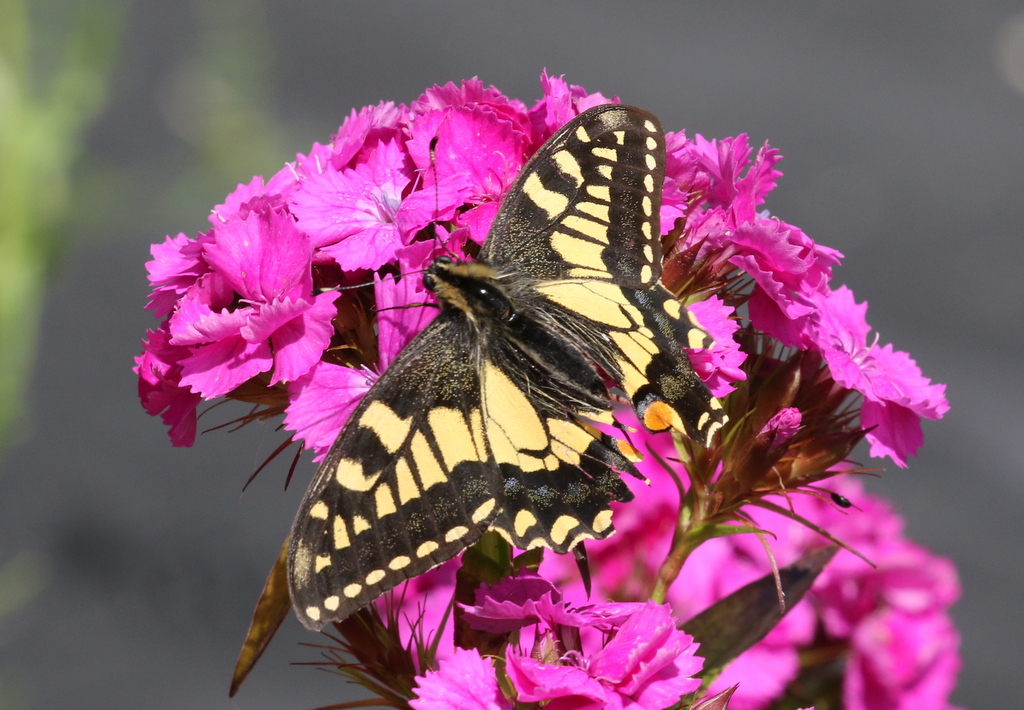
The Swallowtail was not the smartest individual, having sustained some damage and lots its ‘swallow tails’, but it was still good to get a close look at one. There were several Brimstones around the garden too, including a pair which were engaged in courtship flight. When the Swallowtail eventually flew off, we headed back round by the Reception and out onto the reserve.
It had clouded over again now, so there were not as many insects out as earlier now. We had a quick look at the Common Twayblades on the edge of the trees and stopped to watch a Bank Vole which climbed up into an elder and was feeding on the flowers. A flock of Long-tailed Tits flew through the bushes. There were a few damselflies in the vegetation around the pool at the start of Meadow Trail, including Large Red and another Variable alongside the commoner Azure Damselflies. A Marsh Click Beetle was perched on the top of a broken dead reed stem.
The wind was catching the bushes out along Sandy Wall and there was not so much to see out here. We did find a single Large Skipper in a sheltered spot and someone brought over a Buff-tip moth they had just found, to show us. A Willow Warbler was singing, appropriately, in the willows and a Reed Warbler from down in the reeds.
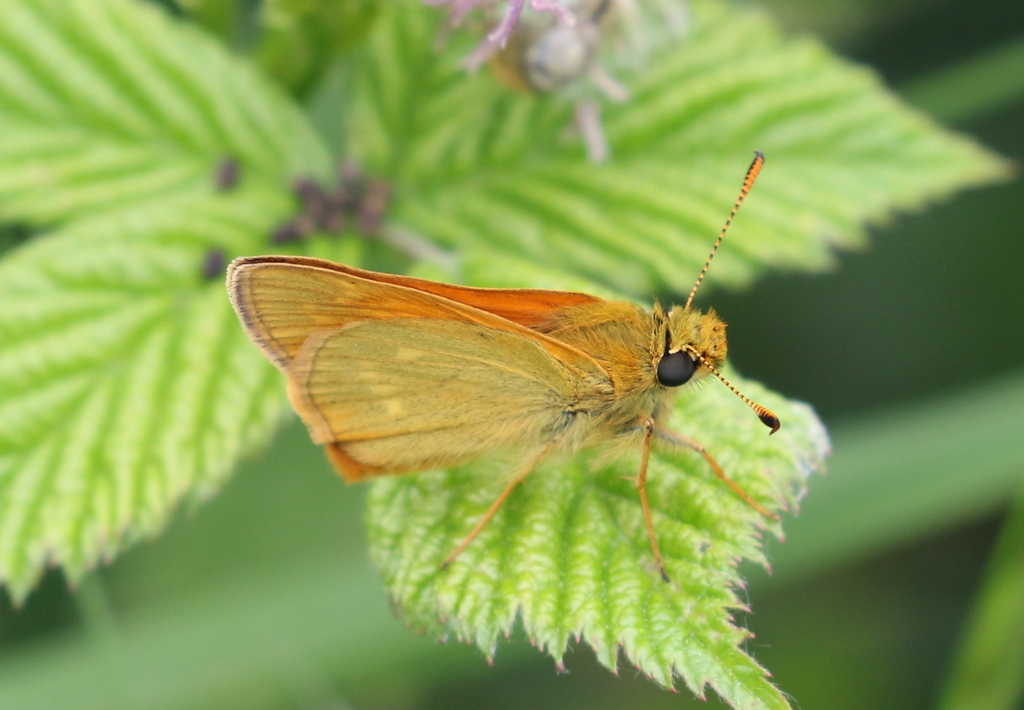
Fen Hide can often be quiet, but we decided to have a quick look just in case. It was nice just sitting there listening to the wind in the reeds. A Marsh Harrier was perched in the top of one of the trees out in the middle of the reedbed, and several Common Swifts were zooming back and forth low over the reeds, but there were few other birds here.
We had just got up to leave when someone else in the hide announced ‘I think I’ve got a Bittern‘. A quick scan confirmed there was indeed a Bittern, which had just climbed into the top of the reeds in front of the hide. It was tucked down in amongst the reeds at first and harder to see. It ruffled its feathers and had a shake, then stretched its neck up out of the reeds to look around, at which point it was much easier to get onto.

The Bittern stayed in the top of the reeds, looking around for a few minutes. It seemed like it was getting ready to fly, checking that the coast was clear first. Then suddenly it was off, labouring up heavily clear of the reeds and then disappearing off back away from us over the reedbed.
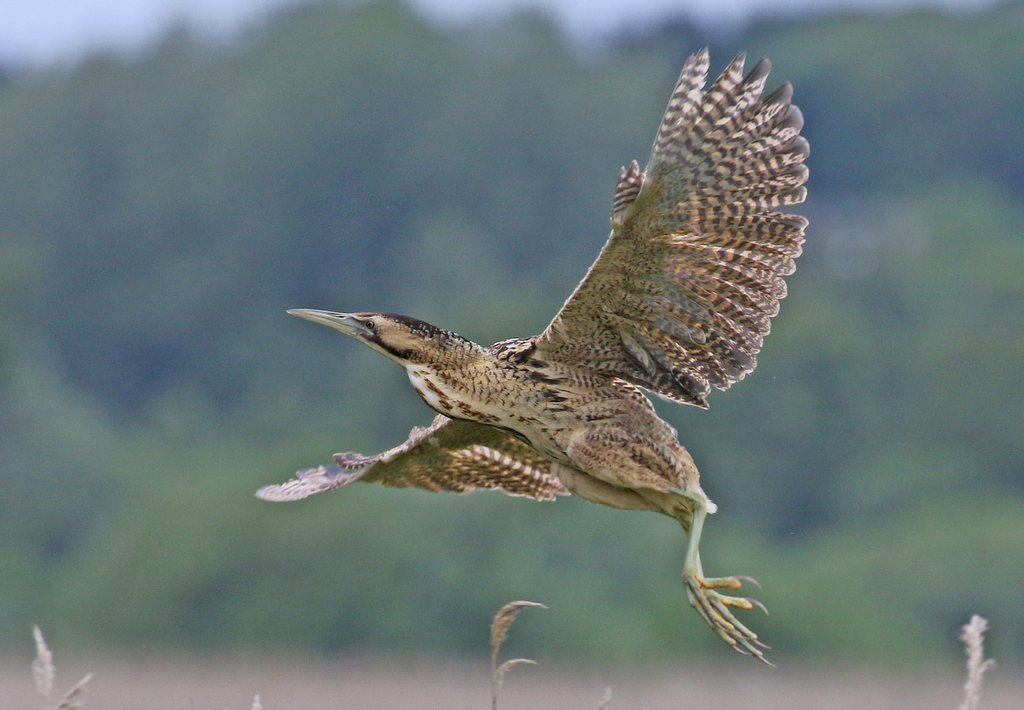
That was a great way to finish off our day in the Broads, so we made our way back to the minibus, for the long drive back. We were almost home when we spotted the Little Owl in the window of the same old barn where we had seen it perched earlier. This time, it stayed put when we stopped, but disappeared inside again before we could all get out.
Nightjar Evening
After a break to relax and get something to eat, we set off again in the evening. We drove back round to where we had seen the Little Owl and third time lucky, got a better look at it. It was more active now, out hunting around the barns. It flew and landed on one edge, right next to the road, as we drove up, but flew back and landed on the edge of the roof. We stopped a discrete distance away and got out, getting a good look at it before it flew again and disappeared round the far side. We got back in the minibus and drove slowly past. The Little Owl was perched on a low wall just beyond the barns and we had a really good look at it from the bus.

Our next target was Barn Owl, so we drove down towards the coast and round by an area that they usually like to hunt. There was no sign of any here, so we parked and set off down along a track through the marshes. It was cloudier here than it had been inland, and there was a fresh breeze blowing. A Red Kite was perched on a post. We flushed a Grey Partridge from the track, which flew out and landed on the grazing meadows. We got it in the scope and could see its orange face as it stood in the grass calling.
We heard Bearded Tits ‘pinging’ from the reeds behind us, and turned to see two juveniles climbing up into the tops. We had some great views of them as we stood and watched over the next few minutes, as the looked for food in the top of the reeds. Two more juveniles flew in and joined them, but the when the adult male flew in it dropped straight down into the reeds out of view.
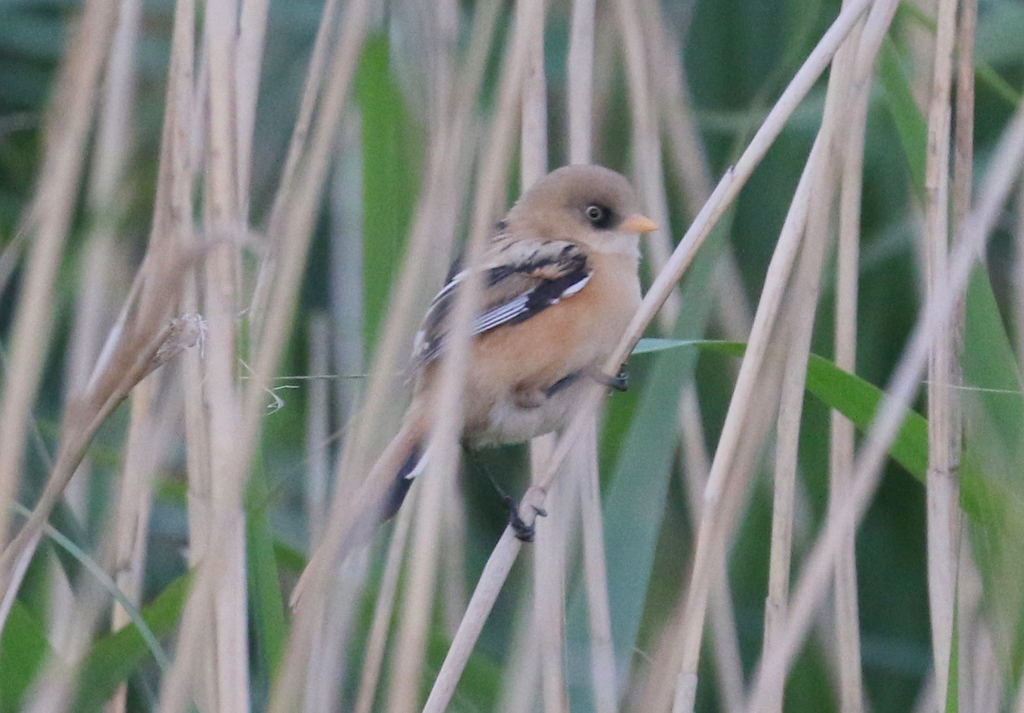
There was no sign of any owls out here, so we turned to go. As we walked back to the minibus, we spotted a Barn Owl flying through the bushes the other side of the road. It was carrying prey and disappeared into the trees. A few seconds later it was back out again – it clearly had young to feed in a nest somewhere in there. It did well to catch something else almost immediately, and went back up into the trees again. When it flew back out, we drove round to the area where it appeared to be hunting. There was no sign of the male Barn Owl but a female flew back past us heading for the nest.
We needed to get a move on now, or we would late for the evening’s main event. We headed inland to one of the heaths to look for Nightjars. With the cloud tonight, it was getting dark quickly as we walked out to the middle. The first Nightjar of the evening started churring in the trees.
A squeaky call alerted to a Woodcock overhead. We turned to see it flying past, with rhythmic beats of its wings, roding. We would see it or another Woodcock several times this evening, flying over in this distinctive display flight.
We were had just arrived at the territory of one of the Nightjars when it started churring in the top of an oak tree right ahead of us, beside the path. Unfortunately it was on the far side from us, and when we started to walk round it flew, dropping off the branch with its wings raised, before flying out into the middle of the heath. We could still hear it churring in the distance.
We stood hear and listened for a while – then the Nightjar flew back in right past us. We thought it might be heading for another of its favourite churring posts, but instead a second Nightjar appeared, the female. The two of them flew round just above our heads calling. They did this several times, drifting away before coming back in for another look. The female disappeared but the male came in again, right over our heads, hanging in the air at times with its wings raised and tail fanned, flashing its white wing and tail patches. Amazing to watch!
The male Nightjar then flew up into a nearby oak tree and started churring again. Through a gap in the leaves we could see it perched on a branch, silhouetted against the last of the light, and we got it in the scope. Then it dropped out of the tree and flew out across the heath again. It started to spit with some very light rain now – which was not in the forecast! We stood and listened to it churring from some trees in the distance, then the male came in and flew round past us once more. The light was going fast, so we decided to call it a night.
As we walked back to the minibus, two more Nightjars had started churring further over. We had a brief glimpse of one silhouetted against the sky as it flew past. Back at the car park, yet another Nightjar was churring across the road and a Tawny Owl was hooting away in the distance.
















